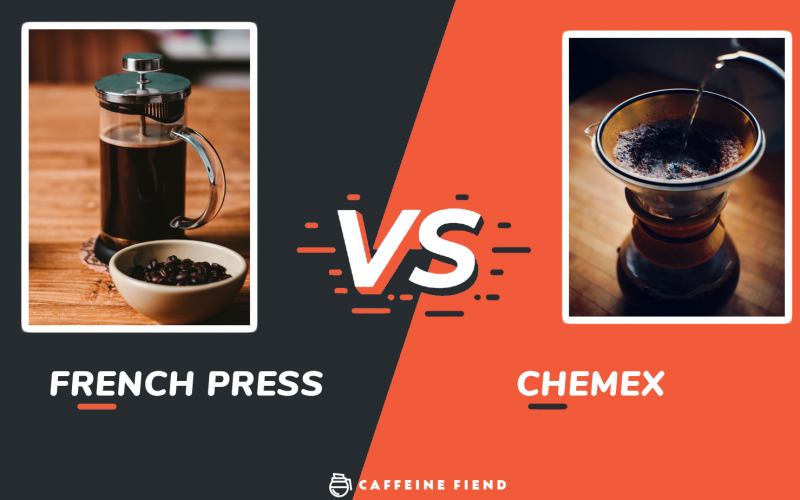The Chemex and the French press are two of the most beloved coffee brewing methods.
They both produce a great cup of coffee, provide more brewing control than drip coffee or K cups, and they involve a bit of skill, patience, and technique that you won’t get from your run-of-the-mill Mr. Coffee pot or single-serve coffee pod.
But let’s compare Chemex vs French press.
On paper both devices are pretty similar. They’re both glass vessels designed for holding hot liquids producing delicious coffee; they even use the same sized coffee grind. However, what sets them apart is not so much their function as the way they go about it.
The main difference lies in the extraction process, or how each piece of kit infuses the flavor of the coffee beans into hot water. One uses percolation brewing while the other uses immersion. This means that the final product is, indeed, quite different.
But, let‘s answer some key questions:
- How are these brewing methods different?
- Which is better for coffee lovers?
- Which brews the best coffee?
Showdown: Chemex vs French Press Coffee Maker
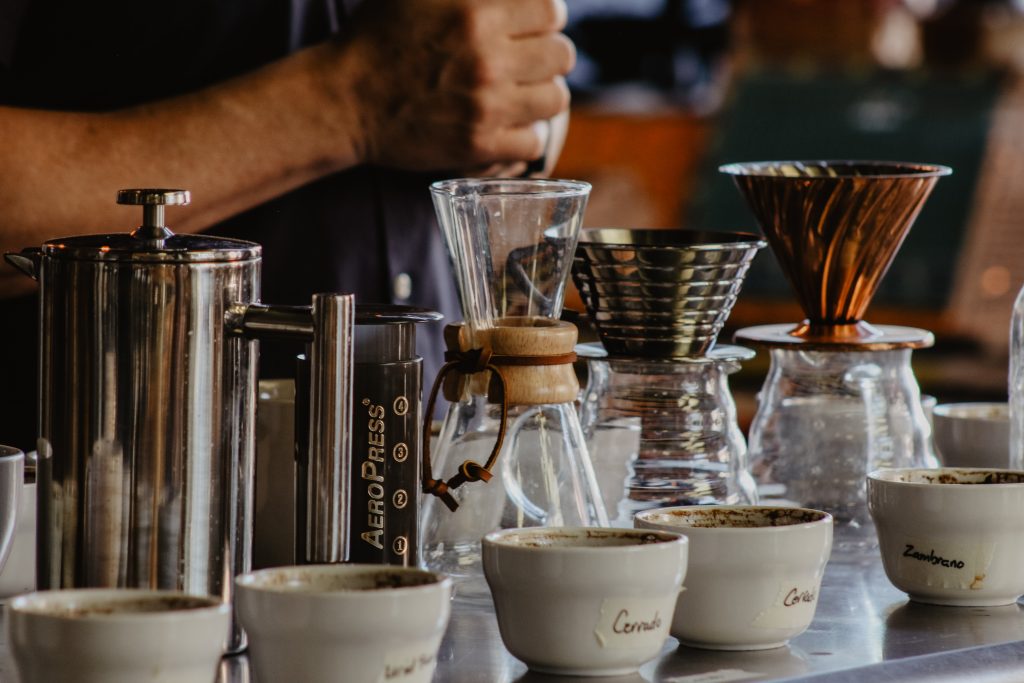
Compared to other brewing methods, Chemex and the French press offer a relatively simple way to brew quality coffee in a relatively short amount of time.
Each is simple to both set up and clean. They’re also both pretty cheap, meaning amateur coffee enthusiasts can make the leap from amateur to intermediate coffee guru without breaking the bank.
Compared to say, espresso, which requires a large upfront investment in order to purchase an espresso machine, the Chemex and French press cost about $45 and $35, respectively, depending on which make and model you choose.
For such a cheap and simple way of brewing, both methods also offer the brewer amazing control over the final flavor of the coffee. Expensive coffee machines offer different degrees of variation, whereas the Chemex and French press allow for a much more intuitive brewing experience.
While both produce a great cup, they don’t produce the same kind of coffee.
In fact, when we look at them side by side, it’s clear that you’ll get quite a different product from each method.
| Chemex | French press | |
|---|---|---|
| Brewing | – Brews through percolation – Filtered coffee; clear | – Brews through immersion – “Unfiltered” coffee |
| What to expect | – Lighter, cleaner cup – More complex brewing process – More delicate coffee taste | – More coffee oils and sediment – More acidity (acid flavor) – Richer, fuller mouthfeel |
| Startup costs | $40 – $60 | $35 – $50 |
| Ongoing costs | More expensive over time (paper filters) | Just coffee |
Chemex Pour Over Coffee: A Deep Dive
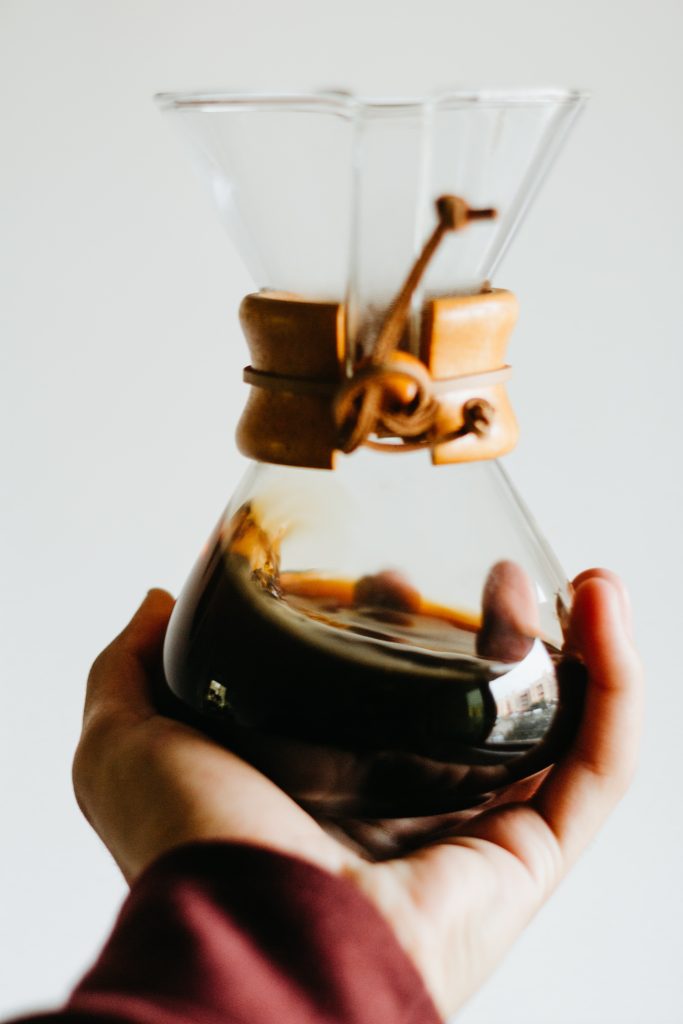
The Chemex is a manual, pour over coffee maker. Originally developed in 1941 by German inventor Peter Schlumbohm, although it’s enjoyed a recent resurgence in popularity among the coffee community and it’s a favorite for baristas and coffee shops.
It’s no wonder, either – the Chemex is absolutely beautiful to look at. It’s simple yet tasteful hourglass design makes it a wonderful asset to any decorated kitchen worth its salt, and that’s before even a drop of coffee has been brewed.
The wooden collar and leather tie also deserve a mention. As the third and final piece in the Chemex setup (after the carafe and the disposable filters), it’s the most visually-distinctive feature. Fitting around the neck, the collar is heatproof and allows the Chemex to be handled safely even when full of hot coffee.
Materials & Construction
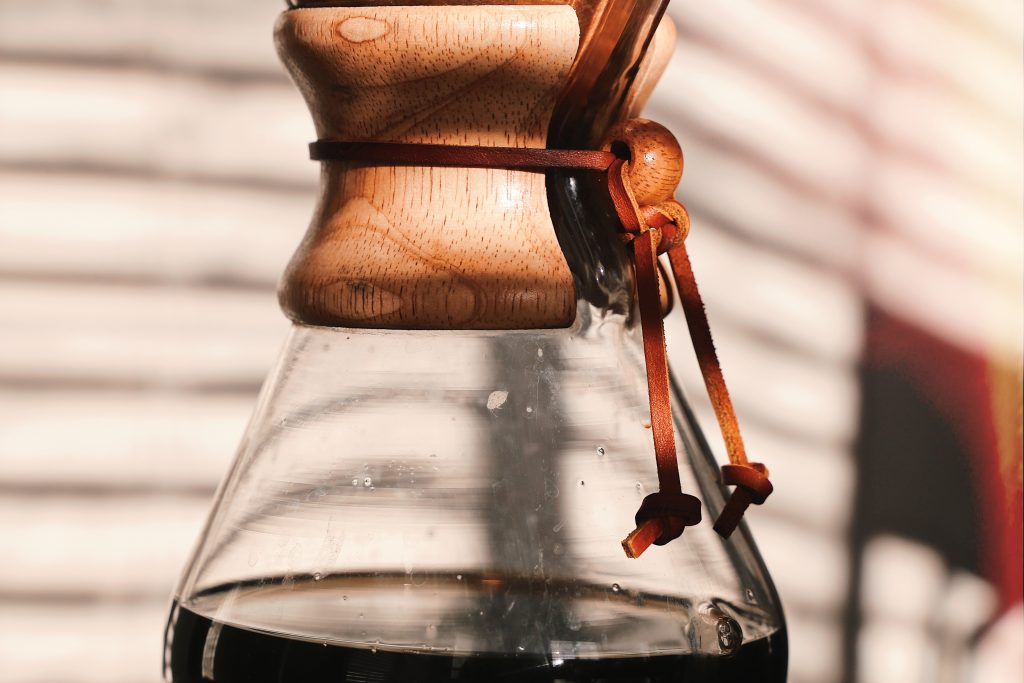
This is a one-piece hourglass design constructed of Borosilicate glass.
Being constructed entirely of glass makes the Chemex slightly more delicate than other brewing devices. But it’s not exactly what I would consider “fragile”. The construction is rigid.
Best of all, the glass constructions means no flavor, leeching, or BPA concerns that you may run into with other brew methods.
Filter
What makes this coffee really unique are the Chemex filters.
Special bonded paper filters are recommended with the Chemex. They’re thicker than standard filters and feel almost like cloth.
Plus they have a distinct double-fold design that some people find frustrating or confusing but ultimately make for the signature cup of coffee that this device is known to brew.
In a nutshell: The special filters trap almost all of the oil and sediment released from the coffee grounds.
What you end up with is a remarkably clear and clean cup of coffee that highlights the more delicate flavors that you see in the tasting notes.
Brew Process
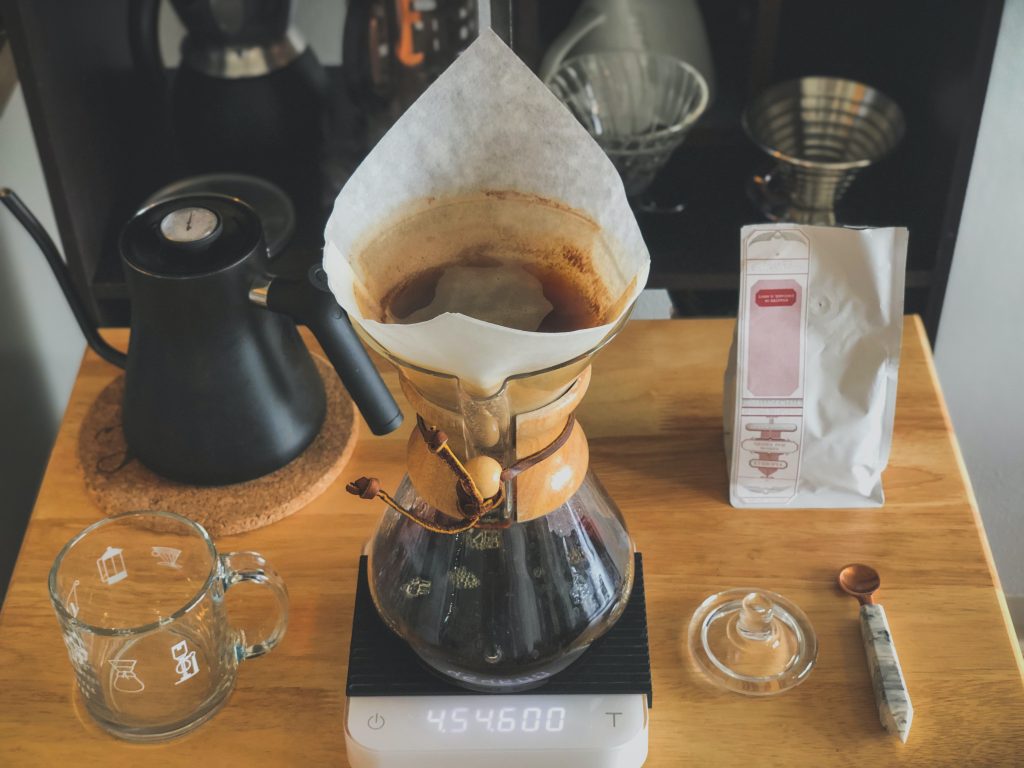
The Chemex brew process is essentially the same as any pour over.
You simply add coffee grounds to the filter and then pour water over the grounds, letting it filter through.
It seems simple. But because the brewed coffee depends entirely on how long the grounds and water commingle, the water temperature, filter (size, shape, fold), and grind size are all super important.
It’s also important to note that this isn’t a set-it-and-forget it brew method.
You’ll need to perform 2 to 4 separate pours while making coffee.
It’s important not to rush the process.
Unlike other brewing methods, like the Aeropress or French press, making coffee using a Chemex isn’t going to result in a cup of coffee more bitter than Cersei Lannister. Quite the contrary, due to the thick filters used and the fact that the extraction process occurs as water passes through the grounds, the coffee made by the Chemex is smooth, light, and easy to drink.
Pour gradually and deliberately, taking care to let the water drain through the grounds before adding more. Your patience will be well-rewarded a large amount of nuanced coffee that’s great for sharing with friends.
Brew Time
You can brew the perfect cup of Chemex coffee in about 4 minutes.
That the time it takes for the hot water to filter through the coffee grinds and down into the carafe.
Coffee to Water Ratio
Digging into Chemex brewing, you’ll want to use a ratio of 15:1.
This means that you brew with about 15 grams of water for every 1 gram of coffee beans.
Grind Size
You’ll use a medium-coarse grind to maximize flavor and minimize acidity or over extraction.
Because of the thicker bonded paper filters, you don’t want to a medium-fine grind like with other pour-over coffeemakers.
Instead, you want something closer to the French press but just a bit finer.
Coffee Flavor
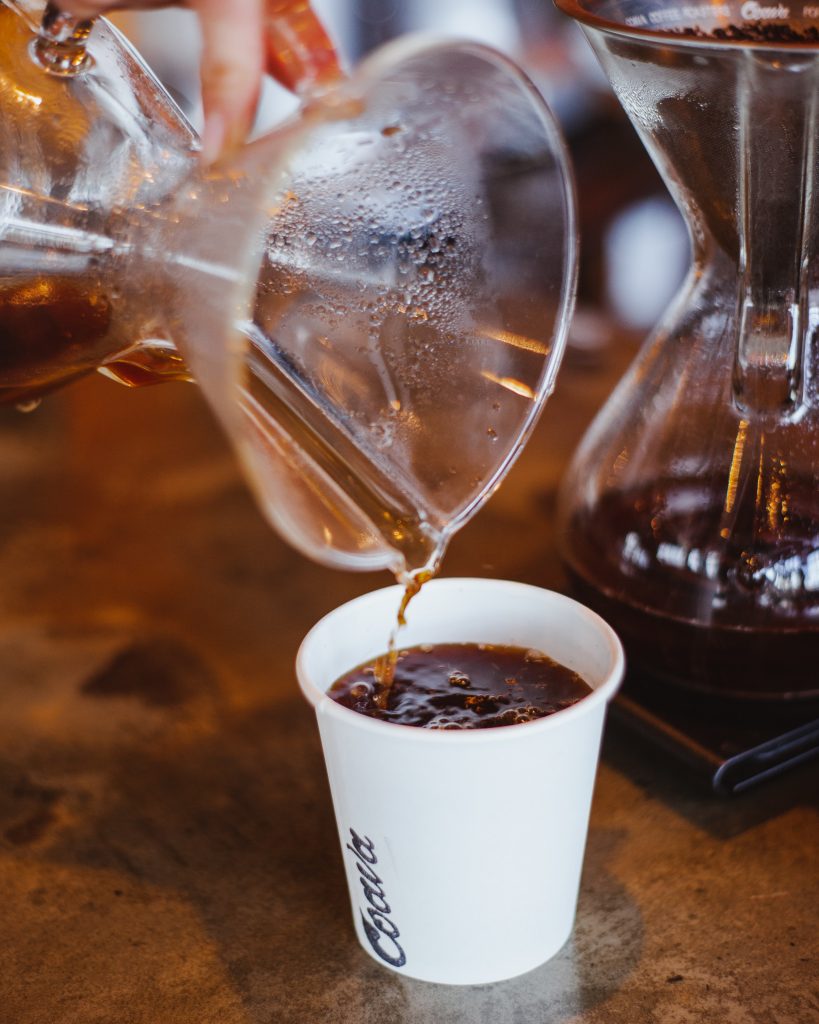
Ultimately, what really matters is how the coffee tastes.
And in the case of the Chemex, you should expect a light, clean cup that highlights the aromatics and flavors noted on the coffee beans. You’ll likely be able to pick out more of the citrus and fruit notes.
In a word: Delicate.
Again, because of the filtering method, you won’t get the oils or acidity. The mouthfeel is thin. The flavor is complex.
French Press Coffee: A Deep Dive
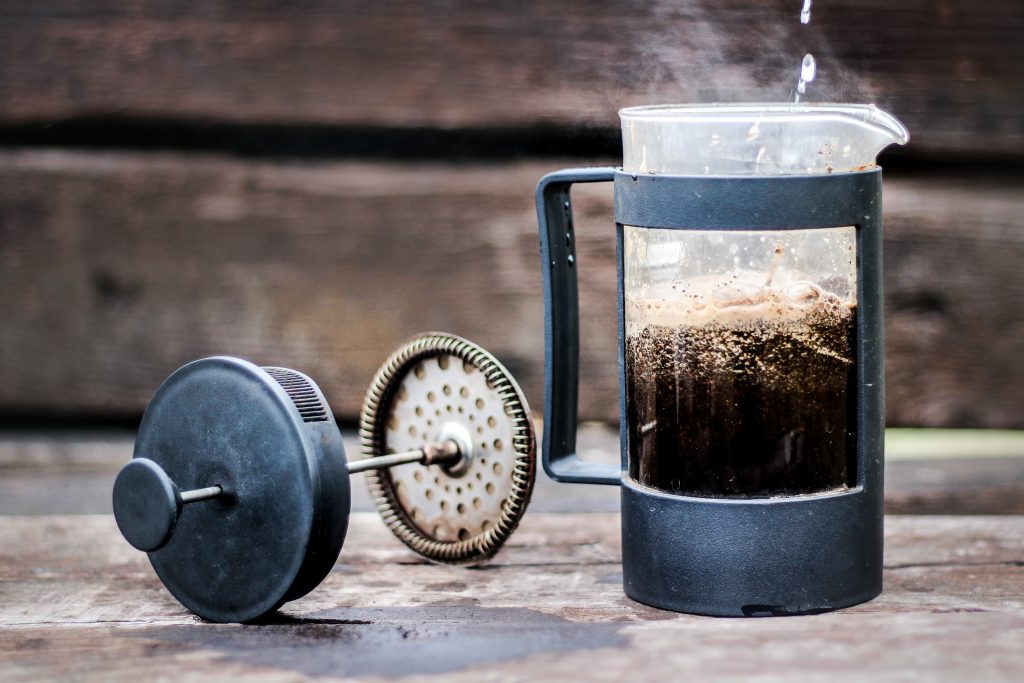
Making French press coffee is decided simple — and effective. Unlike other similar devices, the French press provides an extremely thorough extraction processes by fully immersing the coffee grounds in hot water.
The design has been argued about for over a century and originally invented in France (or was it Italy?) as far back as 1852.
This immersion technique means that the coffee is being continuously extracted into the brewed coffee rather than being carried away and replaced with clean water.
Notably, the French press doesn’t use a paper filter.
Materials & Construction
These devices are generally two pieces:
- The carafe — Generally made of glass and steel or just steel (usually for camping)
- The lid — Includes a plunger and steel mesh filter.
Filter
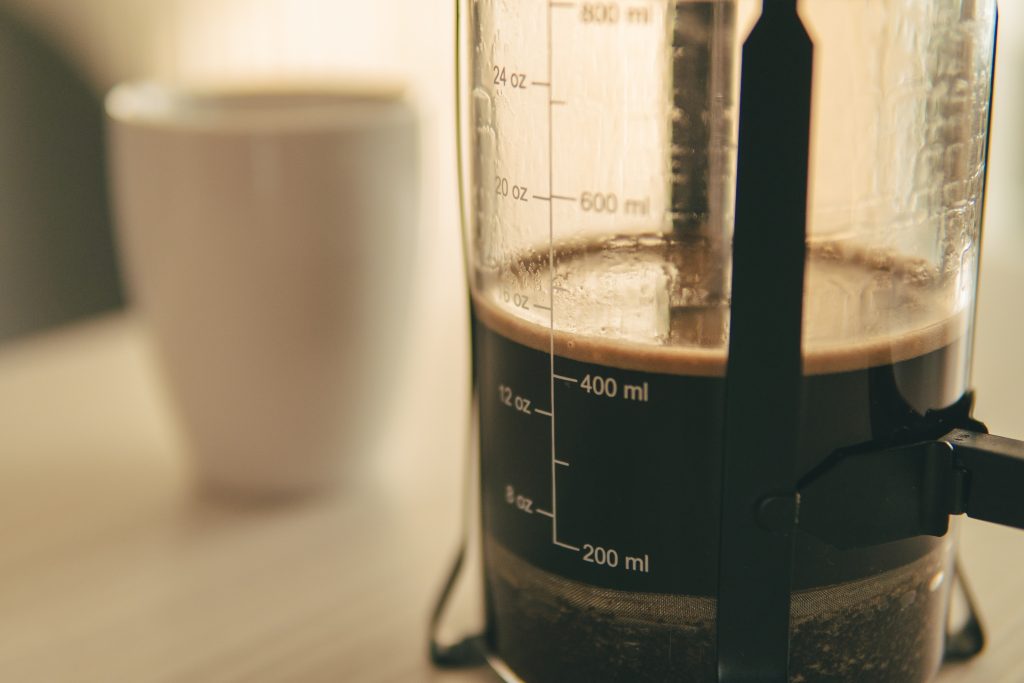
French press coffee is brewed using a usable metal mesh filter that both ”presses” the grounds and also filters the coffee before it’s poured.
On the plus side, you won’t need to keep stocking up on new coffee filters.
This makes it better for the environment, reducing waste. And it saves you a bit of money.
But because it’s not as fine as paper, the filter won’t ”catch” as much. This means that you’ll end up with more oil, sediment, and a deeper, richer, stronger coffee flavor.
Brew Process
The secret of the French press lies in the fact that the grounds are allowed to fully saturate in the water before they’re filtered. Other methods, such as the Chemex or pour over, rely on extraction to occur as hot water is passing through the grounds.
By allowing the grounds to steep fully, broader, more intense and more complex flavors are allowed to develop.
The other big difference is that you pour all of the water at once.
Rather than multiple pours (“pulse pouring”), you can simple pour, wait, and press.
But, unlike K Cups or other methods, you still have a much higher level of control.
Manipulation of crucial variables such as water temperature, water volume, coffee volume, and brewing time, you have the ability to make your coffee as strong or as weak as you’d like.
Brew Time
Other the boiling water, the brewing and steeping process is quick.
After pouring the hot water into the carafe with the coffee grounds, let it steep for about 4 minutes before pressing the plunger.
Coffee to Water Ratio
Use a 15:1 ratio with the French press. This means that for any amount of coffee, you should use 15 grams of water for every 1 gram of coffee beans.
Grind Size
French press uses a coarse ground coffee.
Because the filter is made of steel and not as fine as a paper filter, using a finer coffee grain will with either flow straight through, rendering it ineffective, or it may clog the filter and make it difficult (or even impossible) to press the coffee.
You should feel a little resistance when pressing down on the plunger, but if it seems extremely difficult then you’re probably using too fine of a grind.
Coffee Flavor
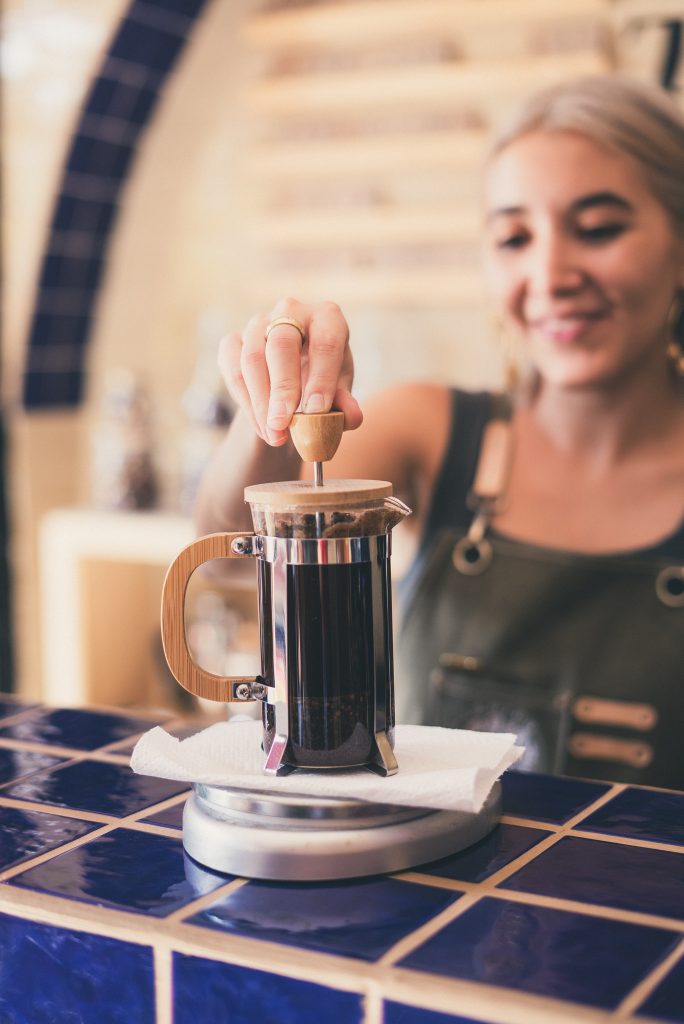
Finally, we get to what matters most.
How does French press coffee taste?
Again, in a word: Bold.
Because of the added oils and sediment, you should expect your French press coffee to taste rich and strong. It will have a heavier, frothier mouthfeel.
For some, this is exactly what they like in a cup of coffee. But, for others, it can be overpowering. You probably won’t be able to pick out all of the subtle nuance of the specific coffee beans and their origin or growing conditions.
Chemex vs French Press – Which Coffee Maker Should You Buy?
Okay, let’s make the final call.
If you’re ready to graduate from a simple automatic drip coffee machine and get more hands-on with your brewing, which device is right for you?
Like most things within the coffee world it’s difficult to give an absolute answer. Different brewing methods allow for so much flavor variation of the final product that definitively stating that one technique trumps another is almost impossible. But if you’re a true coffee enthusiast, all the different methods of brewing coffee should be exciting to one degree or another.
Based on my personal experience, I’d say the choice really comes down to what you’re looking for in a cup of coffee.
- French Press: Full-bodied, aromatic, and intense flavor
- Chemex: Lighter, smoother, delicate, complex flavor
One final thing to consider would be the cost.
The French press is probably the most affordable option for brewing an above-average daily pot of coffee.
Because you don’t have to buy pods, filters, or anything else to brew, you’ll save money every month and it will certainly add up over time.
Recommended Chemex Coffee Makers
Nothing beats the Classic Series Coffee Makers by Chemex — the only things you need to think about before buying one is its capacity, the filters, and the kettle.
We’ve listed three different Chemex Coffee Maker sizes below, plus our favorite gooseneck kettles and Chemex coffee filters:
- Chemex Classic Series 3 Cup Coffee Maker
- Chemex Classic Series 6 Cup Coffee Maker
- Chemex Classic Series 8 Cup Coffee Maker
- Chemex Bonded Filters (These fit the 6 and 8 cup models above)
- Chemex Bonded Half-Moon Filters (These fit the 3 cup model)
- Choose the Best Gooseneck Kettle for Pour Over Coffee here
Recommended French Press Coffee Makers
When it comes to choosing the right French Press, we look at construction and capacity. To keep it simple, there are two types of French Press builds to choose from: glass and stainless steel.
We’ve listed or top pick for each build below (and if you want more details, we’ve written a full buyer’s guide on how to choose the best french press coffee maker here.)
- Veken French press – Available in both 34oz and 12oz options, the Veken French press is an affordable and effective press that is perfect for a first-timer looking to upgrade their coffee game.
- Bodum Chambord French press – the Bodum Chambord is one of the most classic names among coffee equipment and French presses in particular. It’s a trusted brand that will get a nod of approval from coffee enthusiasts everywhere.
- Espro Press P7 – For those uncomfortable with the fragile nature of glass French presses, the Espro Press P7 offers a more sturdy, premium alternative. Made from stainless steel, purchasing an Espro means you’ll never have to worry about accidentally breaking a French press in the pursuit of fine coffee ever again.
- For a Stainless Steel Build, the Frieling Double Wall French Press Coffee Maker is our top choice. It’s more expensive, but more sturdy, easier to clean, and is dishwasher safe.

